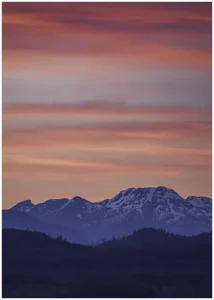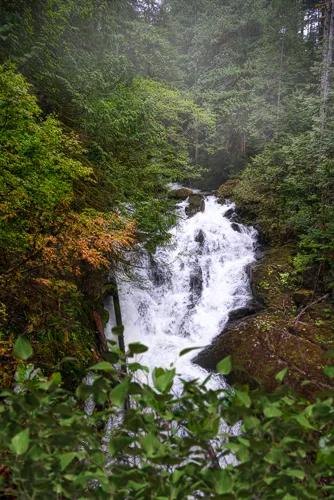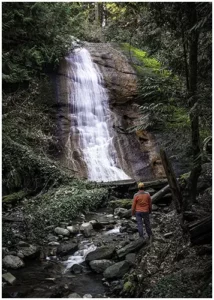
Harness the Power of Light and Shadow in Landscape Photography
In photography, light and shadow are essential for creating captivating photos. It’s important to grasp


Are you ready for another photo adventure into the Wilds of BC? Well, pack your camera bag and head to Little Bear Bay near Campbell River. Why? Because we’re going to photograph some amazing waterfalls and camp under the stars!
Did you know there is a series of waterfalls at Little Bear Bay? You’ll need to do a wee-bit of bushwhack before arriving at a series of stunning waterfalls. Where you’ll be able to capture some truly amazing waterfall photos. Once you’re done shooting, unwind at your campsite by relaxing and enjoying the sounds of nature.
So grab your camera gear, your tent or camper, and your sense of adventure. Let’s head out to Little Bear Bay for another waterfall experience!
Little Bear Bay Recreation Site features ten camping spots suitable for both tents, trailers and motor homes, as well as a rough boat launch. There are also several short trails in the area that lead to waterfalls, with giant fir trees along the way. It’s a great place to go hiking, and fishing for trout or salmon. In the fall, the river is overrun with salmon returning home to spawn. It is a great place to watch the bears and eagles feed.
From Campbell River
The road into Little Bear Bay is suitable for two-wheel drive vehicles and is very scenic. It’s also possible to camp at nearby Pye Lake or Stella Lake, both of which offer plenty of campgrounds.
Usually I start off with telling you to research the area, but isn’t that why you’re here reading this post? Unfortunately, I couldn’t find a PDF for the area. However, using Google Maps should work just fine. There is no need for satellite and topographic maps. The route to the falls is easy to find, and you shouldn’t get lost; just follow the path.
Okay, don’t yell – the path is at the bridge. To be more specific, if you are not camping in the area. Park just before the bridge to the fish hatchery. No need to cross the bridge. If you see the sign stating private land, you have gone too far. Once parked, walk to the bridge and scramble down the rocks on the left-hand side.
Prior to leaving on a photographic excursion, it’s crucial to check the weather. Weather can vary here on Vancouver Island depending on the season; knowing what to expect is essential. It’s important to bring the right clothing. The wind can also be quite strong. It may rain, or snow, so it is important to check for precipitation ahead of time to ensure that your photographic equipment is not damaged.
By checking the weather before heading out, you can ensure that you have the correct clothing with you.
When heading out for a photography trip to Little Bear Bay on Vancouver Island, be sure to bring the following items for your camera gear:
Composition is an important aspect of photography. It makes the photo interesting and visually appealing. However, while photographing the waterfalls at Little Bear Bay, it may be difficult to get the perfect composition in camera because of the terrain.
Sometimes the terrain or surroundings may not allow for the perfect composition. Don’t worry, take the shot and crop it later in post-production. Shoot wider than you normally would, leaving room to crop.
For one of my shots, I place the camera on a ledge while I balanced on 1 foot to see the viewfinder. Composition was secondary for the shot.
When planning your photography trip to Little Bear Bay, it’s important to make sure you have the right gear. Here is a list of the filters I take with me.
Polarizing Filter: Great for reducing glare and reflections from rocks and plants.
Neutral density Filter: Can help reduce the amount of light entering the lens, allowing you to capture long exposures.
Graduated neutral density Filter: Used to darken bright areas of a scene, such as a bright sky, while leaving the rest of the image unaltered.
With these filters you’ll be ready to take photos at Little Bear Bay!
When heading out on a photography trip to Little Bear Bay, it’s important to make sure you have the right gear packed.
Pack that tripod! Waterfalls require slower shutter speeds and a tripod will allow you to capture the motion of the water. Hand-holding the camera may result in camera shake and blurry images. A tripod also allows for precise framing and composition, and can be adjusted to different angles and heights to get the perfect shot.
Camping at Little Bear Bay can be an adventure in itself for nature lovers. There are plenty of things to do, fishing for trout and salmon, or watching the sea life paddle by. Hike the trails and explore the area or relax and enjoy the scenery at the bay. So pack your gear, grab some friends or family, and experience the beauty of Little Bear Bay Rec site!
Little Bear Bay Rec site has ten camp spots. They are first-come, first-served. It’s a good idea to arrive early to secure your spot and make sure you get the best spot for your camping adventure. So, if you’re planning to camp at Little Bear Bay, get there early and claim your spot. If you miss out on a campsite, you can try Pye and McCreight Lake.
Amenities
I’m positive you will have a great experience at Little Bear Bay Rec site. It’s important to come prepared. This might include a tent, sleeping bag, cooking equipment, and warm clothing. It’s also important to practice Leave No Trace Principles, which means leaving the campsite as you found it or better and be respectful of the natural environment.
If you’re an avid fisherman, Little Bear Bay Rec site is a great place to cast a line. The area is known for its access to salmon and trout fishing. It’s important to have the right fishing license and follow all fishing regulations.

In photography, light and shadow are essential for creating captivating photos. It’s important to grasp

Looking to kill off an hour while in Nanaimo, BC? Just a short hop-skip and

Photography can be a fulfilling and enjoyable hobby that brings a creative outlet to your